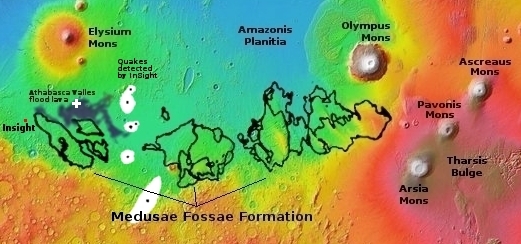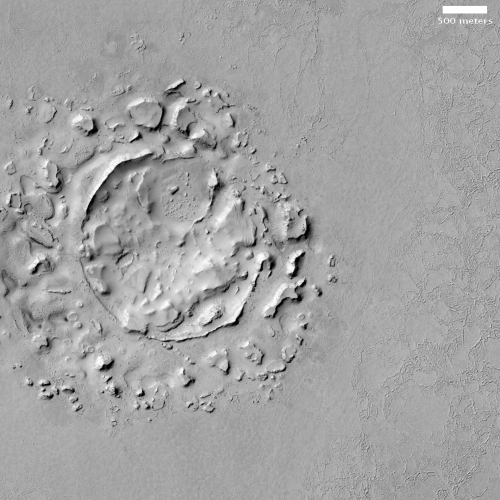Martian lava flooded crater?
A quick cool image! The photo to the right, rotated, cropped and reduced to post here, was taken by the high resolution camera on Mars Reconnaissance Orbiter (MRO) more than a decade ago, on June 1, 2010. I post it now because it is today’s MRO picture of the day, and is definitely cool. The caption:
One of a few “scaly-looking” inselbergs within regional platy-ridged flows in Elysium Planitia. This inselberg has a broken and blocky appearance with some of the blocks being tilted. Could this be the remnant of a once extensive mantling deposit? An inselberg is an isolated hill or mountain rising abruptly from a plain.
The wider image by MRO’s context camera below, also rotated, cropped and reduced to post here, illustrates even more forcefully how isolated this circular set of blocks is.

The circular feature is on the top right, sitting isolated on a very very smooth plain. To the south is another set of isolated blocks, this time not showing any obvious circular pattern. Both appear to be material that has been partly buried by flood lava. The circular feature suggests it is a partly buried and eroded ancient crater.
Make sure you take a look at the full images. Both emphasize how isolated these features are on that flat lava plain. To the south can also be seen a number of single small peaks, sticking out from that plain.
The overview map to the right marks this image’s location by the white cross, sitting inside the Athabasca Valles flood lava plain. This lava flood, about the size of Great Britain, is thought to be one of the youngest on Mars, with an estimated age of between half million to ten million years. It is also believed that it was laid down in only a matter of weeks.
Yet, are these buried features, or are they geology that formed after the flood lava was laid down? The southern collection of blocks appears to resemble chaos terrain, terrain that is seen in many places on Mars and is created by erosion cutting away material along fault lines.
Then again, why have erosion only at these isolated spots, and not across the entire plain?
On Christmas Eve 1968 three Americans became the first humans to visit another world. What they did to celebrate was unexpected and profound, and will be remembered throughout all human history. Genesis: the Story of Apollo 8, Robert Zimmerman's classic history of humanity's first journey to another world, tells that story, and it is now available as both an ebook and an audiobook, both with a foreword by Valerie Anders and a new introduction by Robert Zimmerman.
The print edition can be purchased at Amazon or from any other book seller. If you want an autographed copy the price is $60 for the hardback and $45 for the paperback, plus $8 shipping for each. Go here for purchasing details. The ebook is available everywhere for $5.99 (before discount) at amazon, or direct from my ebook publisher, ebookit. If you buy it from ebookit you don't support the big tech companies and the author gets a bigger cut much sooner.
The audiobook is also available at all these vendors, and is also free with a 30-day trial membership to Audible.
"Not simply about one mission, [Genesis] is also the history of America's quest for the moon... Zimmerman has done a masterful job of tying disparate events together into a solid account of one of America's greatest human triumphs."--San Antonio Express-News
A quick cool image! The photo to the right, rotated, cropped and reduced to post here, was taken by the high resolution camera on Mars Reconnaissance Orbiter (MRO) more than a decade ago, on June 1, 2010. I post it now because it is today’s MRO picture of the day, and is definitely cool. The caption:
One of a few “scaly-looking” inselbergs within regional platy-ridged flows in Elysium Planitia. This inselberg has a broken and blocky appearance with some of the blocks being tilted. Could this be the remnant of a once extensive mantling deposit? An inselberg is an isolated hill or mountain rising abruptly from a plain.
The wider image by MRO’s context camera below, also rotated, cropped and reduced to post here, illustrates even more forcefully how isolated this circular set of blocks is.

The circular feature is on the top right, sitting isolated on a very very smooth plain. To the south is another set of isolated blocks, this time not showing any obvious circular pattern. Both appear to be material that has been partly buried by flood lava. The circular feature suggests it is a partly buried and eroded ancient crater.
Make sure you take a look at the full images. Both emphasize how isolated these features are on that flat lava plain. To the south can also be seen a number of single small peaks, sticking out from that plain.
The overview map to the right marks this image’s location by the white cross, sitting inside the Athabasca Valles flood lava plain. This lava flood, about the size of Great Britain, is thought to be one of the youngest on Mars, with an estimated age of between half million to ten million years. It is also believed that it was laid down in only a matter of weeks.
Yet, are these buried features, or are they geology that formed after the flood lava was laid down? The southern collection of blocks appears to resemble chaos terrain, terrain that is seen in many places on Mars and is created by erosion cutting away material along fault lines.
Then again, why have erosion only at these isolated spots, and not across the entire plain?
On Christmas Eve 1968 three Americans became the first humans to visit another world. What they did to celebrate was unexpected and profound, and will be remembered throughout all human history. Genesis: the Story of Apollo 8, Robert Zimmerman's classic history of humanity's first journey to another world, tells that story, and it is now available as both an ebook and an audiobook, both with a foreword by Valerie Anders and a new introduction by Robert Zimmerman.
The print edition can be purchased at Amazon or from any other book seller. If you want an autographed copy the price is $60 for the hardback and $45 for the paperback, plus $8 shipping for each. Go here for purchasing details. The ebook is available everywhere for $5.99 (before discount) at amazon, or direct from my ebook publisher, ebookit. If you buy it from ebookit you don't support the big tech companies and the author gets a bigger cut much sooner.
The audiobook is also available at all these vendors, and is also free with a 30-day trial membership to Audible.
"Not simply about one mission, [Genesis] is also the history of America's quest for the moon... Zimmerman has done a masterful job of tying disparate events together into a solid account of one of America's greatest human triumphs."--San Antonio Express-News



